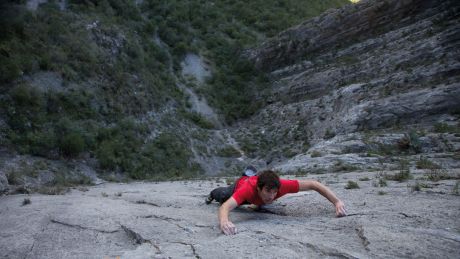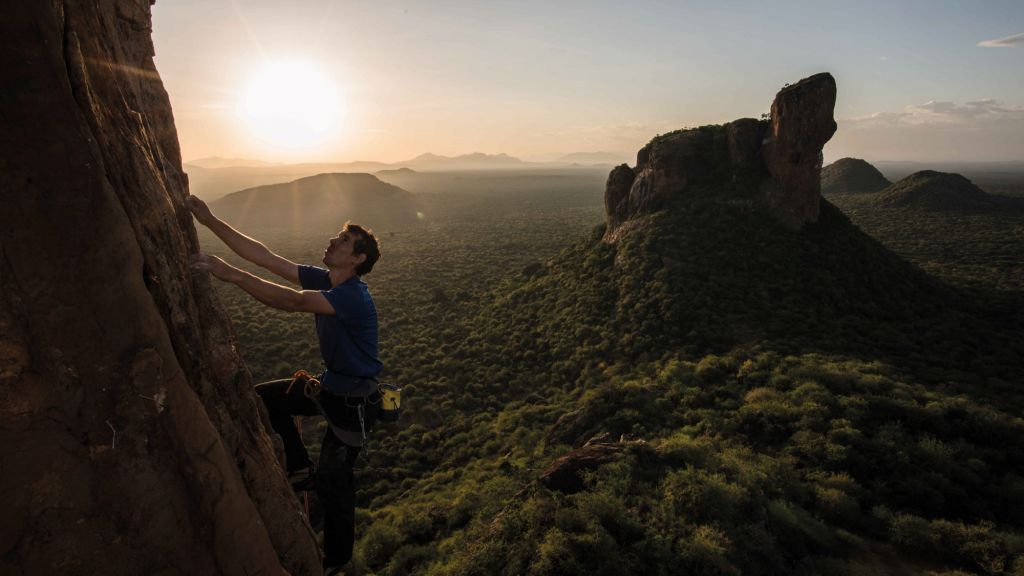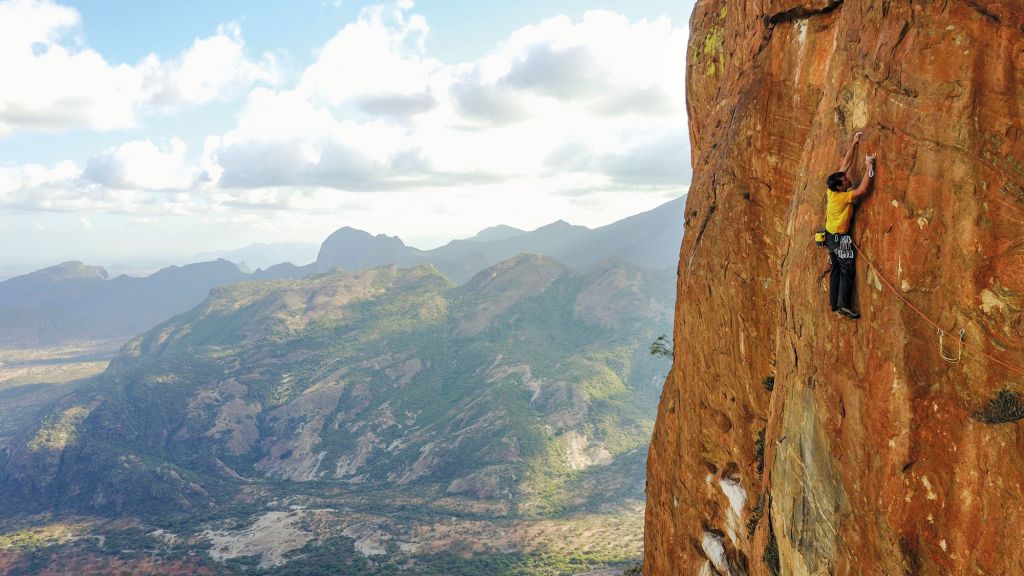Legendary Free Climber Alex Honnold On How To Control Fear

At 5.32am on 3rd June 2017, Alex Honnold began his pioneering ascent of El Capitan, a stark 900m turret of slippery granite in California’s Yosemite National Park. To give you a sense of scale, the towering Shard in London is the tallest building in the UK – and El Capitan is almost three times higher. But unlike other climbers clinging precariously to the wall that day, Honnold had no ropes, harnesses or safety protection. As the world’s leading practitioner of “free soloing” – an exhilaratingly pure but risk-laced type of climbing that involves ascending big walls without ropes, he was equipped only with a pair of climbing shoes and a bag of chalk.
After three hours and 56 minutes of physically gruelling and technically challenging manoeuvres up narrow cracks and fissures – sometimes balancing on ledges the width of matchboxes, at other times hanging only by his fingers above the immense void, and knowing every second that any mistake would lead to his death – Honnold hauled his body over the summit. He had become the first climber in history to climb “El Cap” without ropes – an achievement so groundbreaking that fellow climber Tommy Caldwell called it rock climbing’s equivalent of the Moon landings. National Geographic magazine described it simply as “the greatest feat of pure rock climbing in the history of the sport”.
Honnold, 32, who started climbing aged 11 in his local gym in Sacramento, had already earned a legendary reputation in the climbing community for his daring rope-free ascents, notably of Moonlight Buttress in Utah in 2008 and of the Triple Crown in Yosemite in 2012. However, his eye-catching ascent of El Cap earned him global recognition, wowing non-climbers and climbers alike.
What most intrigues people about Honnold isn’t just the physical fitness and technical skillset required to perform such astonishing climbs, but also the mental control and psychological preparation that makes those feats possible. How does he master fear, doubt and anxiety to excel in such high-pressure, life-or-death situations? And can his system work for the rest of us? We sat down with the man himself to discuss the surprisingly humble and human techniques behind his superhuman psychology.
What were the unique challenges you faced during your free solo ascent of El Capitan?
The main difficulty of El Cap – and there are a lot of difficulties – is the sheer size of it. I climbed it in four hours, which is the fastest it has ever been climbed but it is still not that fast. With four hours of continuous climbing, the fitness component is a challenge. But the first 300m are at quite a low angle, like a slab, which means you have your weight on your feet and there are no real handholds so it is really technical. It feels slippery and unsafe, so one of the main mental blocks was just that you feel like you could slip at any moment. Up higher, the part that was most physically difficult was where you have to pull [yourself up] really hard. So you have this combination of the insecure character of the climb, the difficulty of the climb and the size of the climb. There are a lot of different aspects to get your head around.
What is the emotional appeal of climbing without ropes, given its obvious dangers?
There are a lot of factors. The purity is a big part. The simplicity. The fact you don’t need a partner. I think when I first started to climb I didn’t know other climbers so part of it was just being too afraid to ask someone to belay me and going and doing stuff by myself instead. But definitely the challenge is part of it. There is the feeling of mastery and of working towards something that is really difficult. It is about perfecting your craft. And sometimes it is just more fun because you can cover more ground more quickly.
This climb was the pinnacle of your career. What does it represent to you?
Big solo climbs are what I am most proud of and after El Cap everything else pales in comparison. I loved doing the Fitz Roy route [a complete traverse of Patagonia’s Fitz Roy massif in 2014] with Tommy Caldwell. That is one of the things I am most proud of. I have done a couple of other big climbs in Patagonia which are pretty meaningful to me because they involved big days in the mountains. But I think I have always found soloing the most beautiful experience and El Cap has always been the impossible climb.
Get the Coach Newsletter
Sign up for workout ideas, training advice, reviews of the latest gear and more.

Photograph: Theadore Hesser
To free climb you need strong fingers, forearms and legs, a solid core, and immense flexibility and endurance. How did you prepare physically for the climb?
“Before this climb I was doing hiking and running because I knew in order to practise this route I would need to hike to the top over and over again so I needed good fitness. Now I am trying to focus less on that and more on difficult climbing instead. I want my legs to be smaller because I don’t need to hike up there all day. So my training fluctuates according to my goals. But the physical side is fairly straightforward. You have to be able to climb the route without falling, so first of all you have to be strong and fit enough to not get too tired when you work on it.
You were hanging off a 900m wall of rock without ropes. The big question is: how do you control your fear?
I’m not trying to control the fear exactly. I try to prepare to the point where I’m not feeling afraid because if I was going to feel a lot of fear I wouldn’t go up there. In some ways fear indicates either a lack of preparation or that something has gone wrong. Even something unexpected happening that you haven’t foreseen is a lack of preparation to some extent.
It is not as if I take something very scary and suppress that fear and just do it anyway. I take something scary and I identify the reasons it is scary. I think through which ones are rational and which ones are not, I work through those things, and eventually I do it when it doesn’t feel scary any more.
What did your mental preparations involve?
There was a lot to it. The mental side is in both believing that it is possible and actually knowing how to do it, which means memorising all the sequences and practising, rehearsing and spending a lot of time up there.
How did you ensure you didn’t suffer any nerves or doubts during the climb?
I spent a lot of time considering variations to make sure there was no easier way to do it, partly so that when I got to a challenging section I wouldn’t be wondering in the back of my mind that maybe there was some better way go out on the right or something. I wanted to be 100% committed to what I was doing when I was up there so there was no possibility of hesitation or doubt. That isn’t super-obvious – you might not think that would be a part of my preparation. But it was important to close all those other doors so once I was on that path I knew that was the only path and there were no questions.
How do you react to unexpected scenarios during a climb?
I wouldn’t say I have a process but I deal with those things on a case-by-case situation. The underlying theme is always to rationally evaluate the situation because feeling fear is just a physiological response where there are a lot of things happening in your body. Your vision narrows, your pulse quickens and other things happen. But just because you are experiencing fear it doesn’t change the reality of the situation. It doesn’t mean you are more or less likely to fall off. It just means you think you are about to fall off. Sometimes that means you are in real danger and sometimes it doesn’t.
Being able to use that rational part of your brain, take a step back and evaluate what is going on and make the right decisions, that is the thing. That is a process which gets better with practice. And I have had a lot of practice now.
What was your mindset on the day of the climb?
The climb went more smoothly than I could have hoped for. It was perfect. It was almost like I had over-prepared and I could just show up and feel amazing. But I was still nervous in the morning, or maybe more excited? It’s hard to say exactly. I imagine it is similar to how any other athlete feels when they go into a big day. Going into the Olympics I am sure people are nervous and excited. They know they are prepared so they are excited for the moment.
I was sort of just on autopilot. I just did exactly what I was supposed to do. I did all my preparation on time in terms of packing my backpack and other things. I pre-made my breakfast so I just rolled out of bed, put on my clothes, ate my breakfast and I just went. There wasn’t any room to go off track.

Last year you volunteered for a MRI scan at the Medical University of South Carolina. The scientists discovered that your brain doesn’t react to fear in the same way as other people. What did you make of that discovery?
To some extent it doesn’t matter because I know who I am and I know what I like to do, so it doesn’t matter what somebody tells me about my brain. I know me. I am still me. I am still the same person. I think it was an interesting evaluation but the results are still ambiguous. You can take what you want from it. What I took from it was that I probably started slightly less susceptible to fear than the average person but then I deadened my response to it over time. Other people might look at the same results and they might say they mean I am a freak. But I just don’t think I am naturally like that. I think it comes from years of practice.
Do you find your approach of breaking down fear into rational and controllable components helps you in other areas of your life?
Yeah, I mean a rational evaluation of risk is helpful in all parts of life. For example, I enjoy a rollercoaster. It is fun. It is not scary at all. It is not risky at all. The only risk in a rollercoaster is if something goes wrong, if the rollercoaster breaks and you go flying out on the track, and that is not likely at all. So there is nothing to worry about. It makes sense to look at all life that way and keep risks in the right perspective.
You keep a journal. Does that help with your mental preparation too?
I have two journals going at any time. I have a climbing journal which I have formatted in the same way since 2005. Every single climb or outdoor activity goes into that journal. Then I have another journal which is more for training, lifestyle, to-do lists, goals and random things like keeping track of my diet and my day-to-day calisthenics and supplemental training. That journal is much more varied. I sometimes go a couple of months without writing in that, but my climbing journal has been maintained meticulously since 2005.
People around the world were amazed by your climbs. But what amazes you?
I still love watching climbing movies and reading climbing magazines and I am definitely inspired by other climbers – although personally I’m more inspired by feats of strength. When I see people do things in training, I’m like, “I can’t believe you can do a pull-up with your pinkie finger from that little hold! That is so crazy!” But that’s because the physical side has always been hard for me. I’m not naturally strong in the way some people are and maybe that is why people appreciate [my achievements], because the mental side doesn’t come easily to a lot of people. But I just want to see feats of strength. I can’t believe what people can do. It is crazy.
You’ve already taken climbing to a whole new level. What’s next?
There are a handful of climbs I want to do and tons of locations I would like to go to. I want to go climbing in areas I have never been so that means plenty of adventure travel. I am going to Antarctica this winter so that should be quite the life experience. It will be the seventh continent I have climbed in so it should be fun. But there are still plenty of things to do. It’s only been a few months since El Cap. By this time next year I will have a whole list planned again.
The North Face climber Alex Honnold is a part of the global Walls Are Meant For Climbing campaign, aimed at increasing the accessibility of the sport and bringing the climbing community together. Check out @thenorthfaceuk on Instagram.
Mark Bailey is a features writer and interviewer who contributed to Coach magazine in 2015 and Men’s Fitness UK, which predated, and then shared a website with, Coach, until 2019. Mark has also written for national newspapers including The Telegraph and The Financial Times Magazine, as well as magazines and websites such as Cyclist and Bike Radar.









